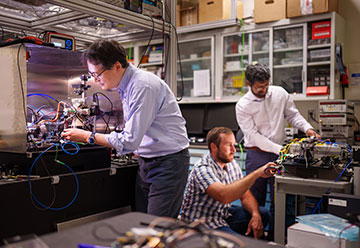
Scientists Jongmin Lee (left), Ashok Kodigala (right) and Michael Gehl prepare an atom interferometry experiment using a silicon-based modulator chip. [Image: Craig Fritz, Sandia National Laboratories]
Researchers at Sandia National Laboratories, USA, have reportedly shown that one of the critical laser systems for a quantum accelerometer can be fabricated on a silicon chip (Sci. Adv., doi: 10.1126/sciadv.ade4454). Their ultimate aim is to create a miniaturized motion sensor based on atom interferometry, which offers extremely precise navigation without the need for a GPS signal.
Going compact
Quantum accelerometers exploit the interactions between beams of ultracold atoms to measure position and motion with high accuracy, but the complexity of the laser systems and the use of discrete optical components make existing demonstrators impractical for widespread use. The Sandia team has set out to create a compact and rugged laser architecture, in which photonic chips performing specific optical functions are integrated into a single photonics platform.
In their proposed design, the light from a single laser is split into independent optical channels that are used for each task in the quantum sensing experiments, such as cooling the atoms and measuring their quantum states. In this new work, they demonstrate a key element of this scheme: a silicon-based modulator that controls the frequency and intensity of each separate light beam, and that also enables phase locking between two independent optical channels.
The modulator exploits a single-sideband design in which the carrier signal and the other sidebands are suppressed, an approach that is particularly useful for multiplexing applications because it makes the most efficient use of power and bandwidth. Such single-sideband operation can be achieved in silicon with two parallel Mach-Zehnder modulators, but achieving the required suppression requires careful balancing of both the optical and radio-frequency signals. In these experiments, the Sandia researchers devised a way to independently control the amplitude and phase of the RF signal in each Mach-Zehnder modulator, improving the sideband suppression to 48 dB from a previous record of 39 dB.
In this new work, they demonstrate a key element of this scheme: a silicon-based modulator that controls the frequency and intensity of each separate light beam, and that also enables phase locking between two independent optical channels.
Applications and testing
The researchers also integrated their modulator chip into a laser system configured for atom interferometry. They show that this system can generate a magneto-optical trap for cooling rubidium atoms and can produce the two hyperfine atomic states needed for interferometry experiments. The setup also enables state-selective detection, which is needed to observe the interference fringes and measure the phase shifts that are important for sensing applications.
Additionally, the team fabricated a silicon chip that integrates four modulators to provide multiple optical channels. As a proof of concept, the scientists used a single channel of this device in a quantum sensing experiment that measured the acceleration due to gravity with an accuracy of 0.1%, and they are now working to scale the laser system to exploit all four optical channels at the same time.
